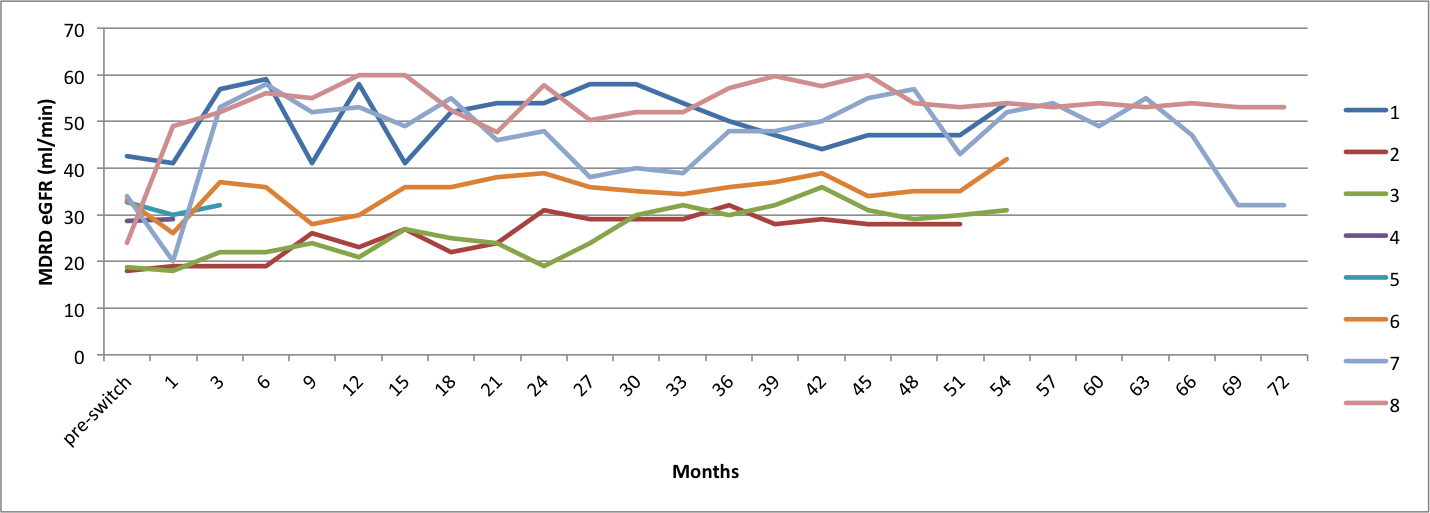Belatacept Based CNI Free Immunosuppression in Pancreas Transplantation. Results at 4 Years
Indiana University School of Medicine, Indianapolis, IN
Meeting: 2019 American Transplant Congress
Abstract number: 200
Keywords: Co-stimulation, Pancreas transplantation, Renal function
Session Information
Session Name: Concurrent Session: Pancreas and Islet: All Topics I
Session Type: Concurrent Session
Date: Sunday, June 2, 2019
Session Time: 4:30pm-6:00pm
 Presentation Time: 5:42pm-5:54pm
Presentation Time: 5:42pm-5:54pm
Location: Room 209
*Purpose: CNI based Immunosuppression is a well known risk factor for worsening renal function. We report our experience in converting Pancreas Transplant recipients from tacrolimus to Belatacept in order to avoid further worsening of kidney function.
*Methods: Chart review was performed on all patients with a pancreas transplant who were maintained on Belatcept maintenance immunosuppression.
*Results: Eight EBV IGG positive (7 PTA, 1 SKP, mean age at start of Belatacept= 52.4+/-7, 7 Females 7 Caucasians) patients initially maintained on tacrolimus, sirolimus and mycophenolate with biopsy proven chronic kidney fibrosis consistent with CNI toxicity were converted from Tacrolimus to Belatacept. Median Follow up of 53.7 months. Mean tacrolimus levels prior to switch were 6.4+/-1.4 ng/ml.Median time from transplant to conversion was 4.7 years (range0.3-9.5). Tacrolimus was weaned off over 4-6 weeks. Patients were maintained on a steroid free regimen of Belatacept, Sirolimus (level 3-6ng/ml) and Mycophenolate. Pre-conversion the mean MDRD eGFR was 29.6+/-9.9., which stabilized or improved over the follow up period to an eGFR of 35.4+/-9.8 ml/min. One patient could not tolerate the oral regimen due to GI side effects and another patient was non compliant. 1 case experienced elevation of Lipase requiring steroid therapy with subsequent successful response and continued on the same regimen with Belatacept. Subsequently at 21 months of Belatacept this subject (2) was found to have spindle cell sarcoma at the head of the transplanted pancreas and underwent a total pancreatectomy. Serum glucose (Mean pre switch 96.98+/-13.9 vs post 101+/-10) , C-peptide (Mean Pre-switch 2.4+/-1.0 vs post 2.3+/-1.2) and Hemoglobin A1c (Mean Pre-Switch levels5.7+/-0.2 vs post 5.8+/-0.2) remained unchanged over the study period. There was no incidence of BK, CMV, EBV, PTLD or Donor Specific Antibody (DSA) noted during prospective monitoring of first 12 months. No other new clinically significant event was noted with the use of this regimen for the 5 cases who have received Belatacept over the median follow up of 4.4 years with stable renal function and proteinuria.
*Conclusions: Belatacept was able to stabilize and improve renal function in patients with CKD intolerant of tacrolimus without any impact on Pancreas outcomes up to beyond 4 years. Larger and longer term studies are needed to ensure the safety of this approach in pancreas transplant recipients in order to preserve kidney function.<
To cite this abstract in AMA style:
Chen J, Fridell J, Yaqub M, Taber T, MIshler D, Adebiyi O, Mujtaba M, Sharfuddin A. Belatacept Based CNI Free Immunosuppression in Pancreas Transplantation. Results at 4 Years [abstract]. Am J Transplant. 2019; 19 (suppl 3). https://atcmeetingabstracts.com/abstract/belatacept-based-cni-free-immunosuppression-in-pancreas-transplantation-results-at-4-years/. Accessed December 22, 2025.« Back to 2019 American Transplant Congress

